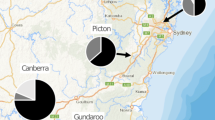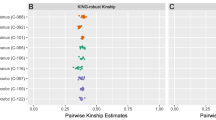Summary
Genetic relatedness in social insect colonies may vary spatially or temporally as a result of changes in colony membership due to immigration or to variation in patterns of maternity and paternity. We estimated relatedness for eastern tent caterpillars (Malacosoma americanum) in laboratory colonies derived from egg masses using multilocus genotypic data derived from electrophoresis. This estimate is compared with estimates obtained from colony samples taken in the field at four intervals spanning the larval developmental season. We found that average intracolony relatedness is close to 0.5 initially but declines through the developmental season due to colony merging, showing that caterpillars do not discriminate between siblings and nonsiblings in order to preserve colony family structure. Using the intracolony values together with relatedness values for higher levels of population structure, we estimated the effective mean number of simple families represented in single colonies through the season. The overall effective number of families per tent increased from one at the time of eclosion to 1.3 by the end of the season. Average intracolony relatedness remained relatively high despite the occurrence of colony merging, apparently as a result of the low density of tents on most trees, combined with high relatedness within the original colonies. Thus, high intracolony relatedness is maintained in M. americanum populations through the effects of adult dispersal, mating, and oviposition patterns, rather than through behavioral discrimination mechanisms of the larvae. These findings underscore the importance of considering the causes of temporal variation in genetic relatedness as well as the consequences for the indirect component of inclusive fitness.
Similar content being viewed by others
References
Bieman DN, Winter JA (1983) Mating behavior of Malacosoma disstria at two levels of mate competition. Fl Entomol 66:272–278
Breed MD, Page RE Jr (1991) Intra- and interspecific nestmate recognition in Melipona workers (Hymenoptera: Apidae). J Insect Behav 4:463–469
Bucher GE (1959) Winter rearing of tent caterpillars, Malacosoma spp. (Lepidoptera: Lasiocampidae). Can Entomol 91:411–416
Courtney SP (1984) The evolution of egg clustering by butterflies and other insects. Am Nat 123:276–281
Crozier RH (1980) Genetical structure of social insect populations. In: Markl H (ed) Evolution of social behavior: hypotheses and empirical tests. Verlag Chemie, Weinheim, pp 129–146
Crozier RH, Brückner D (1981) Sperm clumping and the population genetics of Hymenoptera. Am Nat 117:561–563
Crump D, Silverstein RM, Williams HJ, Fitzgerald TD (1987) Identification of trail pheromone of larva of eastern tent caterpillar Malacosoma americanum (Lepidoptera: Lasiocampidae). J Chem Ecol 13:397–402
Eickwort GC (1981) Presocial insects. In: Hermann H (ed) Social insects, vol II. Academic Press, New York, pp 199–280
Evans HE (1977) Extrinsic versus intrinsic factors in the evolution of insect sociality. BioScience 27:613–617
Fitzgerald TD (1976) Trail marking by larvae of the eastern tent caterpillar. Science 194:961–963
Fitzgerald TD, Peterson SC (1983) Elective recruitment communication by the eastern tent caterpillar (Malacosoma americanum). Anim Behav 31:417–423
Fitzgerald TD, Willer DE (1983) Tent-building behavior of the eastern tent caterpillar Malacosoma americanum (Lepidoptera: Lasiocampidae). J Kansas Entomol Soc 56:20–31
Fletcher DJC, Michener C (eds) (1987) Kin recognition in animals. John Wiley and Sons, New York
Grafen A (1984) Natural selection, kin selection and group selection. In: Krebs JR, Davies NB (eds) Behavioral ecology, an evolutionary approach. Sinauer Associates, Sunderland, Massachusetts, pp 62–84
Hamilton WD (1964a) The genetical evolution of social behavior. I. J Theor Biol 7:1–16
Hamilton WD (1964b) The genetical evolution of social behavior. II. J Theor Biol 7:17–52
Hamilton WD (1972) Altruism and related phenomena, mainly in social insects. Annu Rev Ecol Syst 3:193–232
Holmes WG, Sherman PW (1983) Kin recognition in animals. Am Sci 71:46–55
Inman AJ, Krebs J (1987) Predation and group living. Trends Ecol Evol 2:31–32
Lin N, Michener CD (1972) Evolution of sociality in insects. Q Rev Biol 47:131–159
McCauley DE, Wade MJ, Breden FJ, Wohltman M (1988) Spatial and temporal variation in group relatedness: evidence from the imported willow leaf beetle. Evolution 42:184–192
Page RE Jr, Metcalf RA (1982) Multiple mating, sperm utilization, and social evolution. Am Nat 119:263–281
Pamilo P (1983) Genetic differentiation within subdivided populations of Formica ants. Evolution 37:1010–1022
Pamilo P (1984) Genotypic correlation and regression in social groups: multiple alleles, multiple loci and subdivided populations. Genetics 107:307–320
Pamilo P (1989) Estimating relatedness in social groups. Trends Ecol Evol 4:353–355
Pamilo P, Crozier RH (1982) Measuring relatedness in natural populations: methodology. Theor Popul Biol 21:171–193
Peterson SC (1986) Host specificity of trail marking to foliage by eastern tent caterpillars, Malacosoma americanum. Entomol Exp Appl 42:91–96
Peterson SC (1988) Chemical trail marking and following by caterpillars of Malacosoma neustria. J Chem Ecol 14:815–824
Porter K (1982) Basking behaviour in larvae of the butterfly Euphydras aurinia. Oikos 38:308–312
Queller DC (1993) Genetic relatedness and its components in polygynous colonies of social insects. In: Keller L, Cherix D (eds) Queen number and sociality in insects. Oxford University Press, Oxford (in press)
Queller DC, Goodnight KF (1989) Estimating relatedness using genetic markers. Evolution 43:258–275
Ross KG (1986) Kin selection and the problem of sperm utilization in social insects. Nature 323:798–800
Ross KG (1988) Differential reproduction in multiple-queen colonies of the fire ant Solenopsis invicta (Hymenoptera: Formicidae). Behav Ecol Sociobiol 23:341–355
Ross KG (1993) The breeding system of the fire ant Solenopsis invicta: effects on colony genetic structure. Am Nat (in press)
Ross KG, Carpenter JM (1991) Population genetic structure, relatedness, and breeding systems. In: Ross KG, Matthews RW (eds) The social biology of wasps. Cornell University Press, Ithaca, New York, pp 451–479
Shoemaker DD, Costa JT III, Ross KG (1993) Estimates of heterozygosity in two social insects using a large number of electrophoretic markers. Heredity (in press)
Stamp NE (1980) Egg deposition patterns in butterflies: Why do some species cluster their eggs rather than deposit them singly? Am Nat 115:367–380
Stehr FW, Cook EF (1968) A revision of the genus Malacosoma Hübner in North America (Lepidoptera: Lasiocampidae): Systematics, biology, immatures, and parasites. US Natl Mus Bull 276
Strassmann JE (1981) Parasitoids, predators and group size in the paper wasp, Polistes exclamans. Ecology 62:1233–1255
Strassmann JE, Queller DC (1989) Ecological determinants of social evolution. In: Breed MD, Page RE Jr (eds) The genetics of social evolution. Westview Press, Boulder, Colorado, pp 81–101
Strassmann JE, Queller DC, Hughes CR (1988) Predation and the evolution of sociality in the paper wasp, Polistes bellicosus. Ecology 69:1497–1505
Tallamy DW, Wood TK (1986) Convergence patterns in subsocial insects. Annu Rev Entomol 31:369–390
Tsubaki Y, Shiotsu Y (1982) Group feeding as a strategy for exploiting food resources in the burnet moth Pryeria sinica. Oecologia 55:12–20
Wade MJ (1985) The influence of multiple inseminations and multiple foundresses of social evolution. J Theor Biol 112:109–121
Weir BS, Cockerham CC (1984) Estimating F-statistics for the analysis of population structure. Evolution 38:1358–1370
West-Eberhard MJ (1975) The evolution of social behavior by kin selection. Q Rev Biol 50:1–33
Wilkinson GS, McCracken GF (1985) On estimating relatedness using genetic markers. Evolution 39:1169–1174
Williams JL (1939) The mating and egg-laying of Malacosoma americana (Lepid.: Lasiocampidae). Ent News 1:45–72
Wright S (1951) The genetical structure of populations. Ann Eugen (London) 15:323–354
Author information
Authors and Affiliations
Additional information
Correspondence to: J.T. Costa
Rights and permissions
About this article
Cite this article
Costa, J.T., Ross, K.G. Seasonal decline in intracolony genetic relatedness in eastern tent caterpillars: implications for social evolution. Behav Ecol Sociobiol 32, 47–54 (1993). https://doi.org/10.1007/BF00172222
Received:
Accepted:
Issue Date:
DOI: https://doi.org/10.1007/BF00172222




